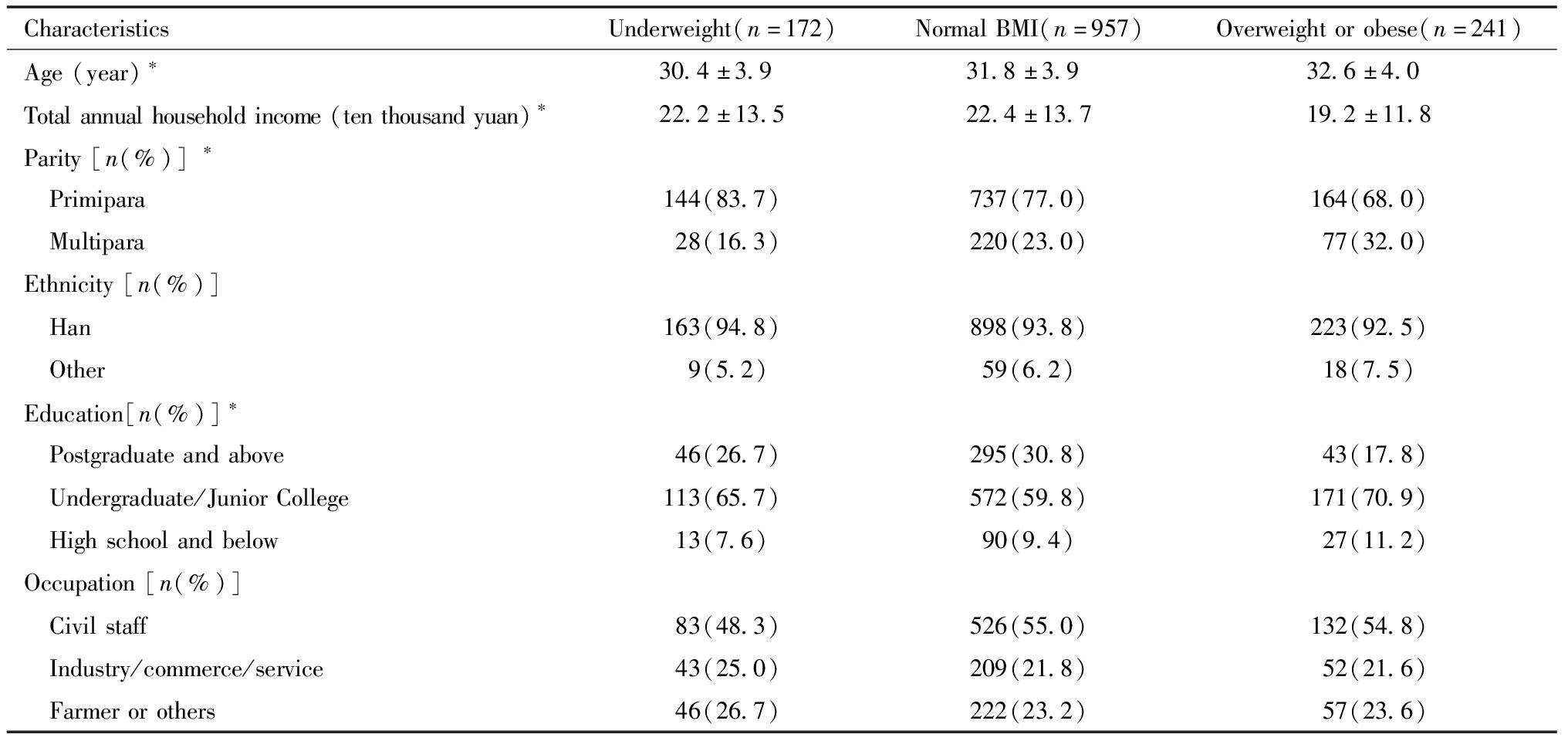正常情况下,由于胎儿的生长发育需求,孕妇在妊娠期间体重会有不同程度的增加[1]。孕期体重增加过高或过低均会对妊娠结局造成不良的影响。孕期体重增加过高会导致妊娠期间代谢疾病,如妊娠期糖尿病、妊娠期高血压发生率的增高,同时会增加早产、剖宫产、大于胎龄儿、巨大儿的风险[2-10],甚至会影响子代的发育[11]。孕期体重增加过低会增加早产和小于胎龄儿的风险[12-14]。了解孕妇孕期体重增加的现状是十分有意义的,研究证实,孕期使用正确的管理方式干预体重可以改善妊娠结局[15]。本研究通过问卷调查的方式对北京市孕妇妊娠早期体重增加情况进行分析,为孕期体重增加的管理方案提供依据。
对象与方法
一、对象
研究对象为2018年1月4日到2018年5月31日在北京市海淀区妇幼保健院产科门诊产检的1 712例孕妇。纳入标准包括:(1)北京市常住居民,孕期在北京生活;(2)年龄在20~40岁;(3)无重大疾病。排除标准:体重数据、末次月经时间及产检时间缺失,孕妇319例;孕前BMI(Body Mass Index)为极端值(BMI<14 kg/m2或BMI>54 kg/m2),孕妇3例;初次产检时BMI为极端值(BMI<14 kg/m2或BMI>54 kg/m2),孕妇7例;最后共纳入孕妇1 370例。
二、方法
1.资料收集:本研究采用问卷调查的方法进行数据收集。问卷内容主要包括基本人口学信息(出生日期、民族、文化程度、职业、家庭收入、孕前体重、身高、月经初潮年龄等)和孕期行为生活方式情况(食物食用频率、吸烟饮酒情况、化学物接触、睡眠时长、药物使用情况等)。根据问卷中所填写的“身高”和“孕前体重”两个变量计算孕前BMI(Body Mass Index,kg/m2)=体重/升高2。根据问卷中填写的初次产检时的“身高”和“体重”用同样的公式计算出初次产检时BMI。按照中国成人体重指数分类标准[16]将孕前BMI分为3组,分别为体重过低组(BMI<18.5 kg/m2)、体重正常组(18.5 kg/m2≤BMI<24 kg/m2)、超重或肥胖组(BMI≥24 kg/m2)。按照孕周将研究对象分为孕周<5周,5周≤孕周≤8周,孕周>8周3组。
根据问卷中所填写的“初次产前检查日期”、“末次月经开始日期”、“初次产检时体重”、“孕前体重”计算孕期增重速率和预计妊娠早期总增重,假设妊娠早期体重增加为线性模式,孕期增重速率(kg/week)=(初次产检时体重-孕前体重)/[(初次产前检查日期-末次月经开始日期)/7],预计妊娠早期总增重(kg)=孕期增重速率×12 week。依据IOM(the Institute of Medicine)标准[17],妊娠早期(即怀孕的第一周至第十二周)孕妇体重增加的推荐范围为0.5~2.0 kg。将预计妊娠早期总增重分为3组,分别为低于推荐标准(<0.5 kg)、符合推荐标准(0.5≤~<2.0 kg)、超过推荐标准(≥2.0 kg)。
2.统计学处理:采用数据录入软件EpiData 3.1对问卷进行平行双盲录入,采用STATA14.1统计软件进行数据分析。采用均数±标准差描述定量资料,计数资料采用百分比(%)描述。分类变量组间比较采用卡方检验,多组均数比较采用单因素方差分析。使用t检验对不同孕期分组的孕前体重和妊娠早期的体重进行检验。P<0.05为差异有统计学意义。
结 果
一、孕妇一般情况
在纳入研究的1 370例孕妇中,平均年龄为(31.7±4.0)岁,平均孕周为(7.0±4.7)周,平均孕前BMI为(21.6±3.1)kg/m2,其中172例(12.6%)属于体重过低,957例(69.9%)属于体重正常,241例(17.6%)属于超重或肥胖。
在本次的研究人群中,体重正常组的孕妇平均年龄高于体重过低组但低于超重或肥胖组,体重正常组的家庭平均年总收入高于体重过低组和超重或肥胖组,体重正常组的初产妇比例低于体重过低组但高于超重或肥胖组,体重正常组中教育水平为研究生及以上的比例高于体重过低组和超重或肥胖组,差异均有统计学意义。见表1。
二、不同BMI分组的孕妇孕期增重情况
在纳入的1 370例妇女中,平均孕周为(7.0±4.7)周,平均孕前体重为(56.6±8.8)kg,平均第一次产检时体重为(57.2±9.0)kg,预计妊娠早期增重的平均值为(1.0±3.5)kg,孕妇的第一次产检时体重平均值均高于孕前体重平均值,见表2。
孕妇预计妊娠早期增重结果与IOM标准比较后,低于推荐标准的有909例(66.4%),符合推荐标准的有140例(10.2%),超过推荐标准的有321例(23.4%)。
根据不同BMI分组进行统计,不同BMI分组的孕妇增重速率的差异有统计学意义,体重过低组孕期增重速率的平均值要高于体重正常组,超重或肥胖组孕期增重速率的平均值要低于体重正常组。IOM对于妊娠早期的增重推荐范围是0.5~2.0 kg,体重过低、体重正常、超重或肥胖组孕妇符合推荐范围的比例分别为14.5%、9.5%、10.0%,差异有统计学意义。见表格3。
表1 不同BMI组孕妇的一般情况
Table 1 Demographic characteristics of pregnant women by BMI group

CharacteristicsUnderweight(n=172)NormalBMI(n=957)Overweightorobese(n=241)Age(year)∗30.4±3.9 31.8±3.9 32.6±4.0 Totalannualhouseholdincome(tenthousandyuan)∗22.2±13.522.4±13.719.2±11.8Parity[n(%)]∗ Primipara144(83.7)737(77.0)164(68.0) Multipara28(16.3)220(23.0)77(32.0)Ethnicity[n(%)] Han163(94.8)898(93.8)223(92.5) Other9(5.2)59(6.2)18(7.5)Education[n(%)]∗ Postgraduateandabove46(26.7)295(30.8)43(17.8) Undergraduate/JuniorCollege113(65.7)572(59.8)171(70.9) Highschoolandbelow13(7.6)90(9.4)27(11.2)Occupation[n(%)] Civilstaff83(48.3)526(55.0)132(54.8) Industry/commerce/service43(25.0)209(21.8)52(21.6) Farmerorothers46(26.7)222(23.2)57(23.6)
*P<0.01, between groups of different variables
表2 孕前体重和第一次产检时体重比较
Table 2 Comparison of pre-pregnancy weight and weight at first prenatal examination

Gestationalage(week)Pre-pregnancyweight(kg)Weightatfirstprenatalexamination(kg)≤5∗56.2±7.656.6±7.65≤^≤8∗56.9±9.257.5±9.4>8∗56.4±9.056.9±9.2Total∗56.6±8.857.2±9.0
*P<0.01, between pre-pregnancy weight and weight at first prenatal examination
表3 不同BMI分组的孕期增重情况
Table 3 Weight gain during pregnancy in different BMI groups

WeightGainGroupUnderweight(n=172)NormalBMI(n=957)Overweightorobese(n=241)Weightgainrate(kg/week)∗0.1±0.40.1±0.30.1±0.3Expectedweightgain(kg)∗1.6±4.41.0±3.20.8±3.7ComparedwithIOMstandard[n(%)] BelowIOMstandard96(55.8)647(67.6)166(68.9) MeetIOMstandard25(14.5)91(9.5)24(10.0) ExceedIOMstandard51(29.7)219(22.9)51(21.1)
*P<0.05, between different BMI groups.
讨 论
本研究发现,不同BMI分组的孕妇孕期增重情况有差异,体重过低组孕妇的体重增长速率高于体重正常组,超重肥胖组孕妇的体重增长速率低于体重正常组。本研究结果表明,孕妇孕期预计增重与IOM标准比较,目前北京市孕妇增重符合IOM标准的人群占比在10%左右。
一项针对四川省成都市妊娠期妇女体重增长的现状研究[18]结果显示,妊娠期间孕妇体重增重过低、体重增重适宜、体重增重过多的比例分别为8.8%、34.3%、56.9%。本研究结果与上述研究差异较大,可能的原因为本研究调查的孕妇多处在妊娠早期,平均孕周只有7.0周,而妊娠早期体重增长的速度较慢,因此本次调查的结果中体重增加低于IOM标准的孕妇占比较高[19],但这一结果也侧面体现了北京市孕妇管理工作的成效,即孕妇能够较早就诊,方便了后续工作的进行。
本研究结果对实际工作有很大借鉴参考。本研究结果显示,不同BMI分组的孕妇孕期体重增长速率之间是有差异的,提示在实际的管理工作中,方案制定者应根据孕妇的孕前BMI数值具体调整管理方式。另外,目前北京市孕妇妊娠早期增重符合IOM标准人群占比较低,提示相关部门应针对孕妇孕期体重增长加强管理和宣传。
本研究存在一定的局限性和不足。首先,本研究所使用的数据为孕妇的自报数据,这一数据在实际的应用中存在包括回忆偏倚在内的缺陷[20]。此外,本研究采取了孕期体重增长是线性的这一假设,虽然这一方案是研究中常用的假设,但仍存在一定的偏倚。
1 Kominiarek MA,Peaceman AM.Gestational weight gain.Am J Obstet Gynecol,2017,217:642-651.
2 Horng HC,Huang BS,Lu YF,et al.Avoiding excessive pregnancy weight gain to obtain better pregnancy outcomes in Taiwan.Medicine(Baltimore),2018,97:e9711.
3 Algeri P,Pelizzoni F,Bernasconi DP,et al.Influence of weight gain,according to Institute of Medicine 2009 recommendation,on spontaneous preterm delivery in twin pregnancies.BMC Pregnancy Childbirth,2018,18:6.
4 Yang S,Peng A,Wei S,et al.Pre-Pregnancy Body Mass Index,Gestational Weight Gain,and Birth Weight:A Cohort Study in China.PLoS One,2015,10:e0130101.
5 Gilmore LA,Klempel-Donchenko M,Redman LM.Pregnancy as a window to future health:Excessive gestational weight gain and obesity.Semin Perinatol,2015,39:296-303.
6 周凤鸣,鲍妍宏,吴成,等.成都市孕前体质指数正常孕妇孕期增重速率对妊娠结局的影响.卫生研究,2018,47:890-894.
7 张亦奇,兰茜,董洪利,等.孕期总增重与不良妊娠结局关系的前瞻性研究.第十三届中国西部营养与健康高峰论坛,2018:1.
8 黄岩.孕前及孕期体重增长对妊娠期糖尿病发病及妊娠结局的影响.中国民康医学,2018,30:70-72.
9 胥芹,杨英,蔺莉,等.孕前BMI和孕期增重与孕期血压水平的相关性研究.中国计划生育学杂志,2018,26:941-946.
10 Parellada CB, sbjörnsdóttir B,Ringholm L,et al.Fetal growth in relation to gestational weight gain in women with Type 2 diabetes:an observational study.Diabet Med,2014,31:1681-1689.
sbjörnsdóttir B,Ringholm L,et al.Fetal growth in relation to gestational weight gain in women with Type 2 diabetes:an observational study.Diabet Med,2014,31:1681-1689.
11 Oken E,Taveras EM,Kleinman KP,et al.Gestational weight gain and child adiposity at age 3 years.Am J Obstet Gynecol,2007,196:322 e1-8.
12 Bengtson MB,Martin CF,Aamodt G,et al.Inadequate Gestational Weight Gain Predicts Adverse Pregnancy Outcomes in Mothers with Inflammatory Bowel Disease:Results from a Prospective US Pregnancy Cohort.Dig Dis Sci,2017,62:2063-2069.
13 Xu Z,Wen Z,Zhou Y,et al.Inadequate weight gain in obese women and the risk of small for gestational age(SGA):a systematic review and meta-analysis.J Matern Fetal Neonatal Med,2017,30:357-367.
14 Ikenoue S,Miyakoshi K,Kasuga Y,et al.Impaired fetal growth in mothers with inadequate gestational weight gain:a retrospective study in Japanese uncomplicated pregnancy.J Matern Fetal Neonatal Med,2018,2:1-5.
15 徐杨,石劢,竺晓婷,等.孕期体重管理对妊娠结局的影响.中日友好医院学报,2018,32:295-297.
16 陈春明,国际生命科学学会中国办事处中国肥胖问题工作组联合数据汇总分析协作组.中国成人体质指数分类的推荐意见简介.中华预防医学杂志,2001,35:349-350.
17 Rasmussen KM,Yaktine AL,editors.Weight Gain During Pregnancy:Reexamining the Guidelines,Washington(DC):National Academies Press(US),2009.
18 陈蓉.成都市妊娠期妇女孕期体重增长现状及影响因素调查.中国营养学会第十三届全国营养科学大会暨全球华人营养科学家大会,2017:2.
19 Santos S,Eekhout I,Voerman E,et al.Gestational weight gain charts for different body mass index groups for women in Europe,North America,and Oceania.BMC Med,2018,16:201.
20 Hutcheon JA,Bodnar LM.Good Practices for Observational Studies of Maternal Weight and Weight Gain in Pregnancy.Paediatr Perinat Epidemiol,2018,32:152-160.